Walkme vs Apty: Which is Better for Interactive User Guides?
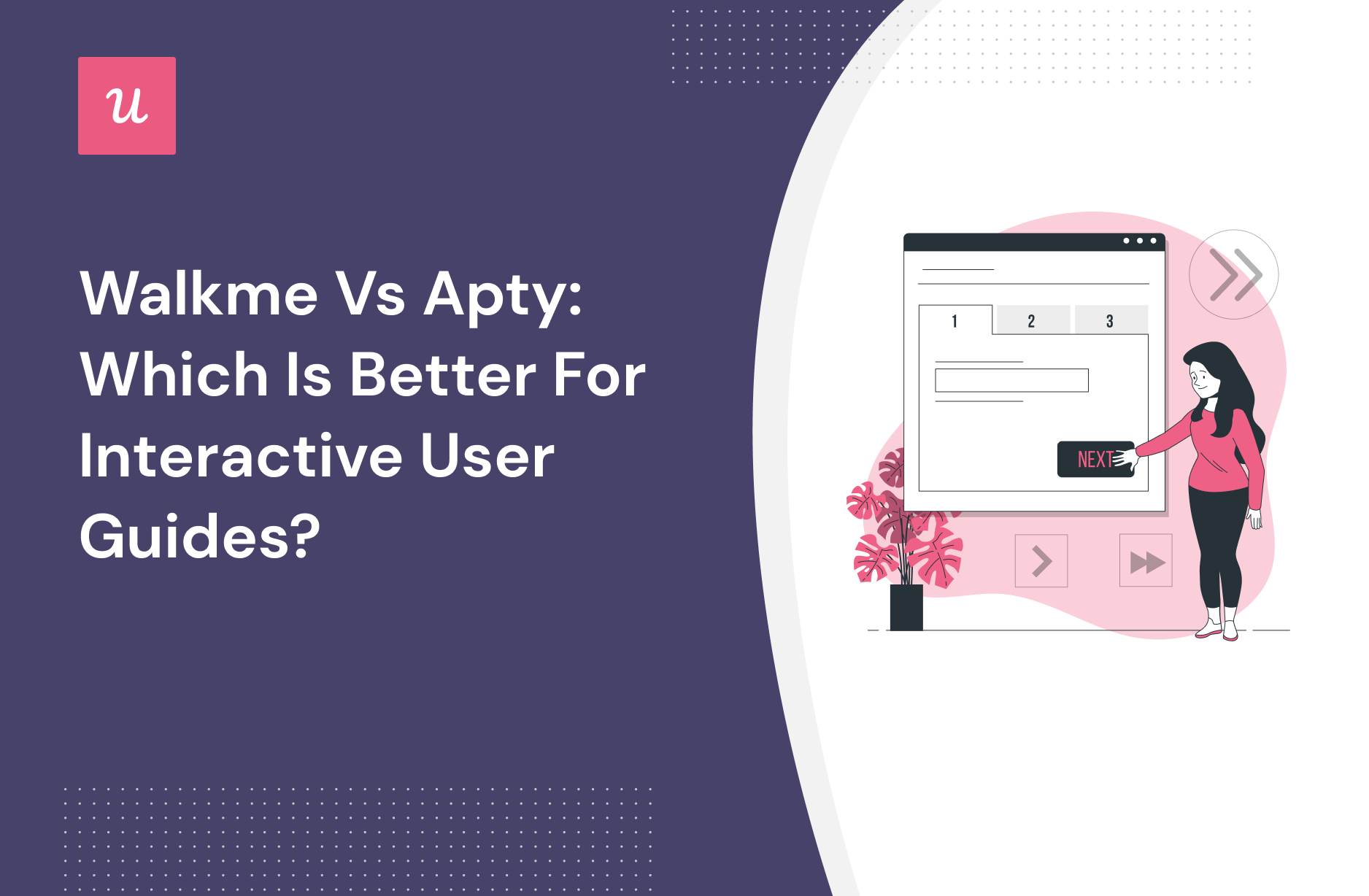
Is Walkme or Apty the best tool for interactive user guides? And is there a better in-app onboarding software that would better fit your needs?
It’s challenging to choose from so many options on review sites.
The tool needs to meet your priorities and provide the functionality you need. Also, your budget needs to be met. Right?
This post discusses what the perfect tool for interactive user guides should deliver and which will be the best fit for your organization.
Let’s dive in!
TL;DR
- Interactive user guides are a set of different UI patterns that help customers get acquainted with the product and learn more about its use cases.
- Interactive user guides improve user onboarding and drive product adoption by engaging users with interactive content relevant to them. They also shorten the time to value and reduce support and customer success cost.
- Using a tool for creating interactive guides decreases the technical barrier, so anyone can quickly create an interactive tour. You can trigger them more contextually to deliver personalized experiences and targeted support.
- Moreover, customer adoption tools make it easy to see which version of an interactive user guide performs more effectively with A/B testing.
- Must-have features for building no-code interactive user guides include a good range of UI patterns, customization and segmentation options, and minimum product usage analytics.
- WalkMe is one of the pioneers in the market of adoption tools. It is a cloud-based software that allows you to create product tours and in-app experiences to drive adoption faster. However, WalkMe is best for enterprise companies as they are focused on employee onboarding rather than user onboarding.
- Apty’s digital adoption platform aims to make employee adoption a snap with engaging onboarding flows and product tours. It does this with a mix of on-screen guidance, interactive walkthroughs, and in-app messaging.
- Apty offers tooltips and checklists for building product experience flows, but unlike other similar tools, it lacks some important UI patterns such as modals, hotspots, banners, and slideouts.
- Apty is a great tool that accelerates the adoption of technologies into employees’ daily workflows. However, it has limited usability.
- Userpilot is a powerful product adoption platform that enables you to quickly build personalized and contextual in-app experiences targeted to different user experiences without writing a line of code. Book a demo to learn more.
![]()
Looking for the best tool for interactive user guides? Search no more!

What are interactive user guides?
An interactive user guide is a set of UI patterns designed to work together and help customers understand how to use your product.
There are two main types of user guides: full product tours (which tend to be more detailed and time-consuming), and interactive manuals (using tooltips and real-time guidance to provide more contextual help to your customers).
Interactive user manuals are an excellent way of engaging and educating your users, helping them to get the most out of your product, and improving user onboarding and feature adoption.
Why should you care about interactive user guides?
All product managers want to delight and engage their customers. A big part of that is making sure your users know how to get the most from your application (and in the modern world, that means more than creating a support documentation page).
Fail in that mission, and you risk damaging customer loyalty. Here’s why building interactive user guides is important:
- Interactive user guides improve user onboarding and drive product adoption. How? By helping real users get value from your product through engaging with interactive content relevant to them.
- Contextual and personalized interactive guides will shorten the time to value and reduce friction in the adoption of your product.
- In-app guides are part of a self-serve onboarding strategy and they reduce support and customer success cost while increasing customer satisfaction. Users just get access to help, when they need it.
All in all, interactive user guides are the backbone of a successful onboarding strategy and should be a must for your user experience,
Why do you need tools for building interactive user guides?
Wondering why you even need a tool to create interactive user guides? There are several reasons why you may need one:
For most software companies, creating interactive manuals from scratch is the wrong approach. Why?
Rather than reinventing the wheel, your developers should prioritize their efforts around enhancing your software – making it faster or more visually appealing – and regularly shipping updates that delight your customers.
Here’s how using a tool can help:
- Rather than a “one size fits all” approach, you can trigger user guides contextually – so based on the specific actions the customer has taken, targeted support is triggered to help them navigate and use the product more effectively.
- With the low technical barrier to entry, anyone -from operations to customer success managers – can quickly create an interactive tour, which means you can reduce reliance on software developers.
- There are dozens of variables you might want to adjust, from small changes to copy to tweaking the design. In a custom-built tool, this represents a significant amount of work – in a no-code tool, it’s incredibly simple.
- Customer adoption tools make it easy to see which version of an interactive user guide performs more effectively with A/B testing (and adapt your approach accordingly).
You shouldn’t question the necessity for a tool to build interactive user guides, but you need to understand what functionality you should look for in a tool and which tools are the best.
Must-have features for building no-code interactive user guides
Not all tools are built the same. Some offer different advantages over others while some will simply get you basic functionality but at a low price. It depends on your budget and needs which will be the best tool to build interactive user guides.
Here’s what to look for as the main functionalities when picking a tool to build in-app guides:
- Good range of UI patterns to use for making your guides.
- Ability to customize each interactive guide to fit your brand and style.
- Segmentation so you could trigger the guides to the right audience at the right time. A one-size-fits-all approach won’t bring you the desired results.
- The ability to trigger the user guides when specific in-app events happen is nice to have and will help you build more contextual in-app experiences.
- Minimum product usage analytics, to be able to track how users engage with the product, and where they get stuck so you can build relevant user guides to help them.
The above list is not exhaustive but it’s a starting point. Depending on your product, you might also need automated localization and A/B testing capabilities. advanced analytics or security, and more.
Walkme for interactive user guides
WalkMe is one of the pioneers in the market of adoption tools. It is a cloud-based software that allows you to create product tours and in-app experiences to drive adoption faster.
WalkMe is best for enterprise companies as they are focused on employee onboarding rather than user onboarding.
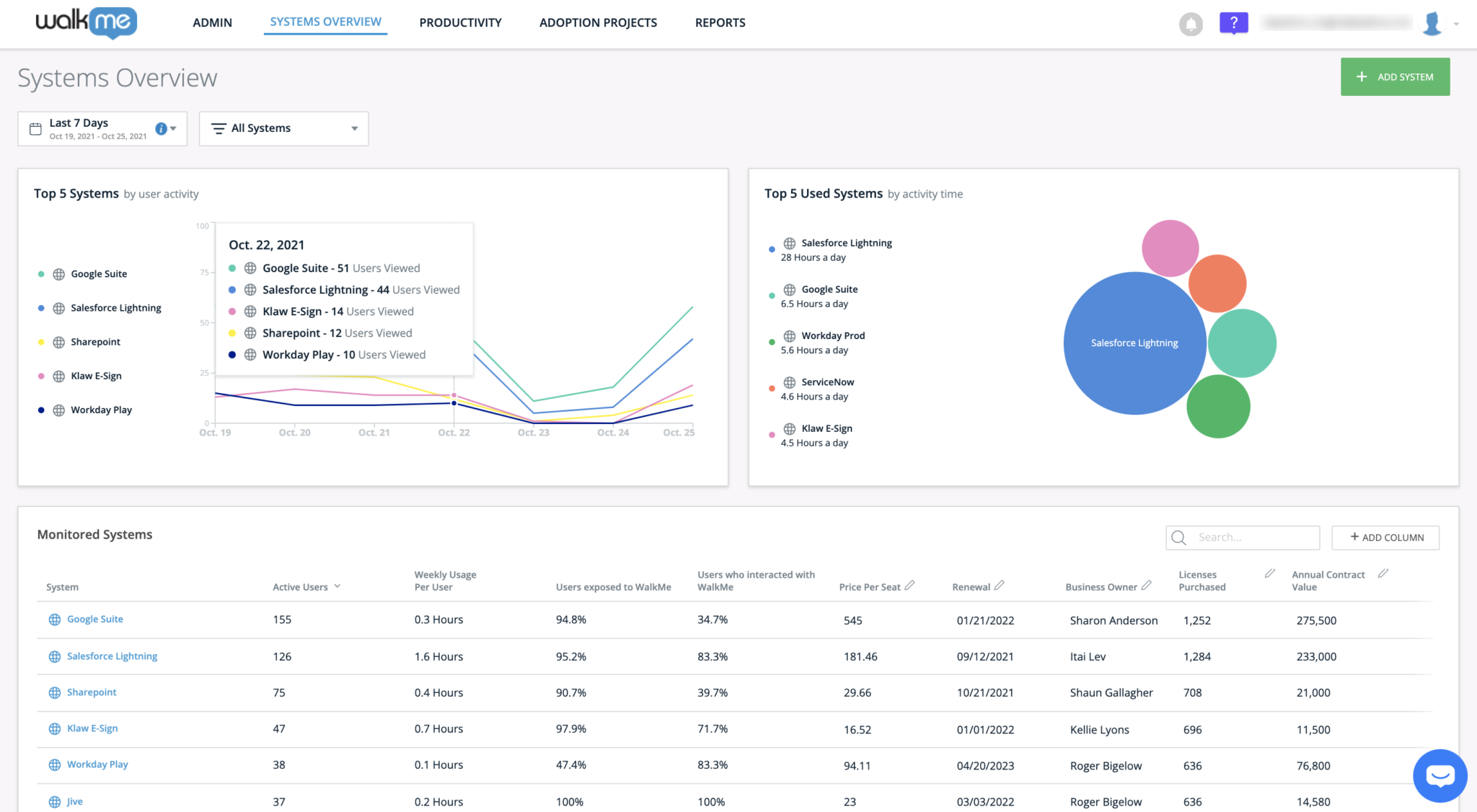
WalkMe platform is a cloud-based digital adoption software catering to enterprise businesses mostly. Typically, it’s used as an employee training tool – for onboarding employees on third-party applications such as Salesforce, Hubspot, Xero, etc.
Additionally, it can be used for onboarding new SaaS users and driving product adoption.
Let’s see what you can do with Walkme to drive product adoption:
- Create onboarding checklists and take new customers through all the important steps they need to get through to get started.
- Create interactive walkthroughs, called WalkThrus to introduce customers to the main functionality of your product and prompt them to take action.
- Use SmartTips (tooltips) to offer contextual hints to customers that will help reduce friction across the journey and drive product adoption.
- Although you can build different UI patterns and drive adoption, WalkMe is not the best tool for the job and it never will be, since it’s not their priority. But if you are in need of a tool that allows you to drive employee onboarding across your tool stack and product adoption of your tool, then this will be a good option for you.
Pros of Walkme
WalkMe has its fair share of advantages that make it a solid tool. So what are WalkMe’s pros?
Here are our top three:
- Offers a high level of customization and works on both your own tool and 3rd party tools.
- Allows you to create in-app quizzes to test user or employee knowledge after completing a flow.
- Get access to a vast list of integrations that simply enhance your data collection or allow you to connect multiple tools in your stack.
Cons of Walkme
WalkMe is an established tool on the market but it does have its own share of cons too.
Here are the main ones you should consider:
- There’s a steep learning curve and a fair amount of technical knowledge required to create WalkMe user guides and get them implemented the way they’re intended.
- WalkMe is designed for enterprise organizations, and its pricing reflects that.
- You could end up spending anything from $9000 to $50000 a year on WalkMe. That’s a lot of money for startups and SMEs.
What users say about Walkme
Users are mostly happy with WalkMe’s features: on-screen guidance, interactive walkthroughs, customizable UI patterns, and journey segmentation are highly used and appreciated by customers.
Here are some reviews from real users.
“The most valuable thing WalkMe provides is time. WalkMe provides the user with on-screen guidance to get them to where they need to be without weighing down support teams on training for every function. The automated steps can remove multiple clicks and quickly send the user to what they need to see. The ability to view user activity and search terms allows mapping new build requirements properly.”
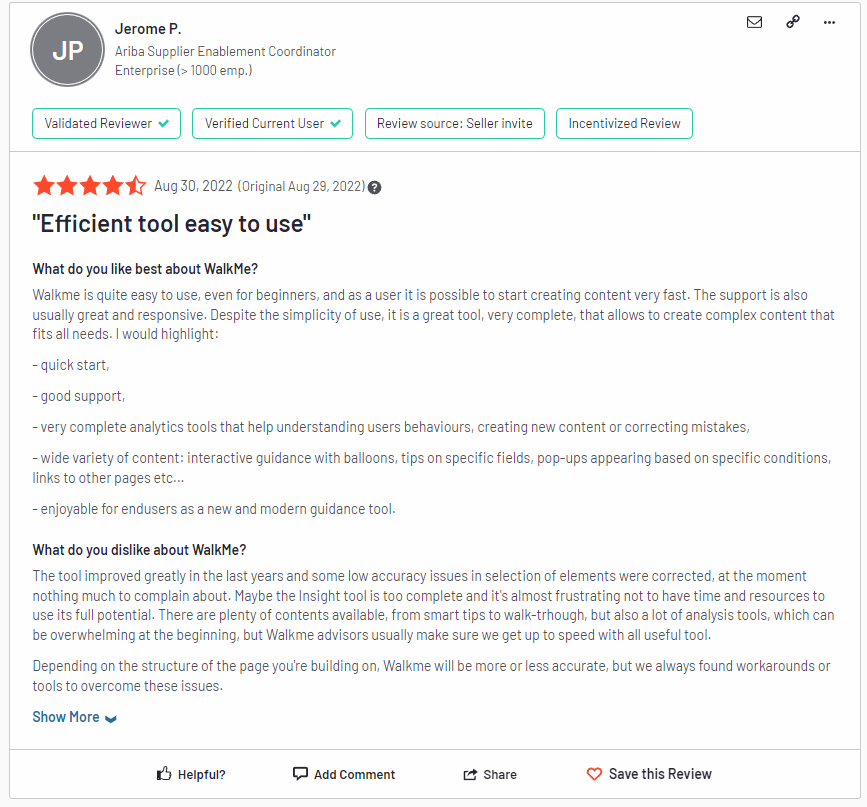
Walkme review.
But Walkme is not a perfect solution, most complaints are about hard implementation and annual contract pricing.
Here are some words from real Walkme users:
We never had time to implement the product. It takes a huge time investment and isn’t designed for the full documentation. Rather than maintain two sets of documentation, we removed Walkme from our product. This company is as bad as AOL or TimeWarner: they will not let you out of your multi-year contract no matter how unhappy you are with the product.
The tool is not very intuitive and has countless challenges using and technical difficulties.
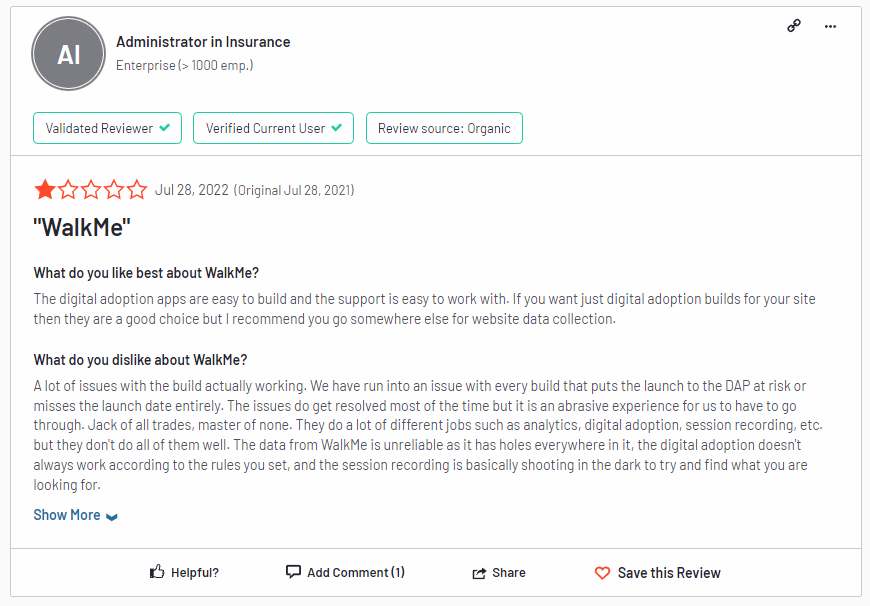
Walkme review.
Is Walkme the right fit for your business?
Is WalkMe all you need or are there better alternatives that can provide more value at a much lower price? Here are the main reasons you should look for an alternative:
- WalkMe offers only yearly pricing contracts which start at $9000 so if you want to onboard new customers or provide in-app guidance then there are better solutions that won’t lock you in.
- WalkMe is known for its hard implementation so it’s not recommended for non-technical people. Generally, it can take weeks or even months. For better comparison, Userpilot can be set up in just a few minutes as it’s completely code-free.
- Bad and outdated UX design is another thing that might disappoint you and make you search for alternatives.
Walkme pricing
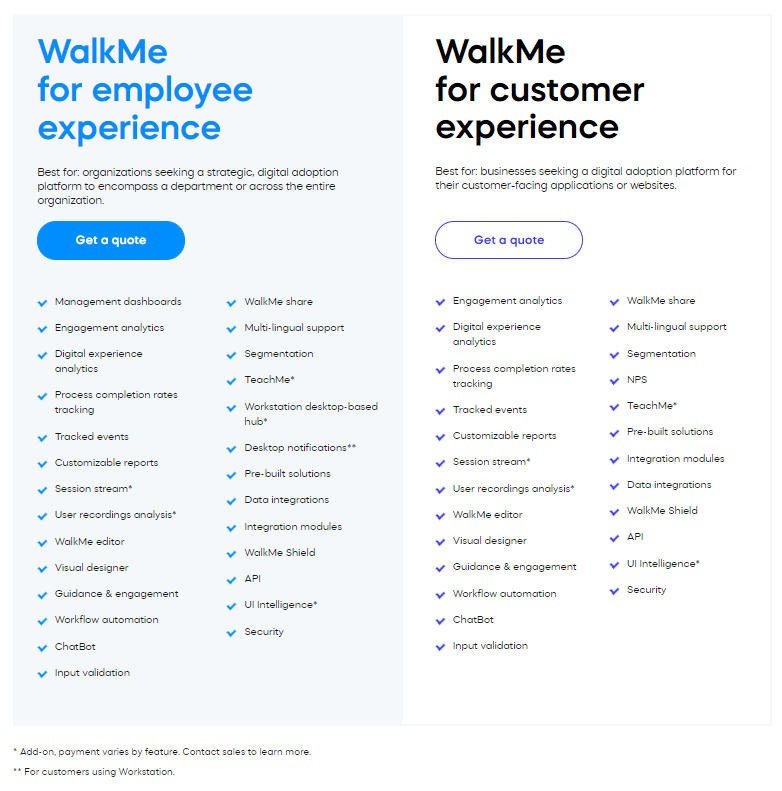
Walkme pricing.
WalkMe works on a custom pricing plan that requires you to request a quote from their sales team (could be spending from $9000 to $50000 a year).
Their main two plans are:
- WalkMe for employee onboarding experience: engagement tools and analytics.
- WalkMe for customer experience: engagement tools and analytics.
- Add-ons: Session Streams, TeachMe, AI analytics through UI intelligence.
![]()
There is a better tool for your SaaS than Walkme!

Apty for interactive user guides
Apty’s digital adoption platform aims to make employee adoption a snap with engaging onboarding flows and product tours. It does this with a mix of on-screen guidance, interactive walkthroughs, and in-app messaging.
This platform is great for engaging your employees on your platform to increase product adoption, feature adoption, and improve the experience.
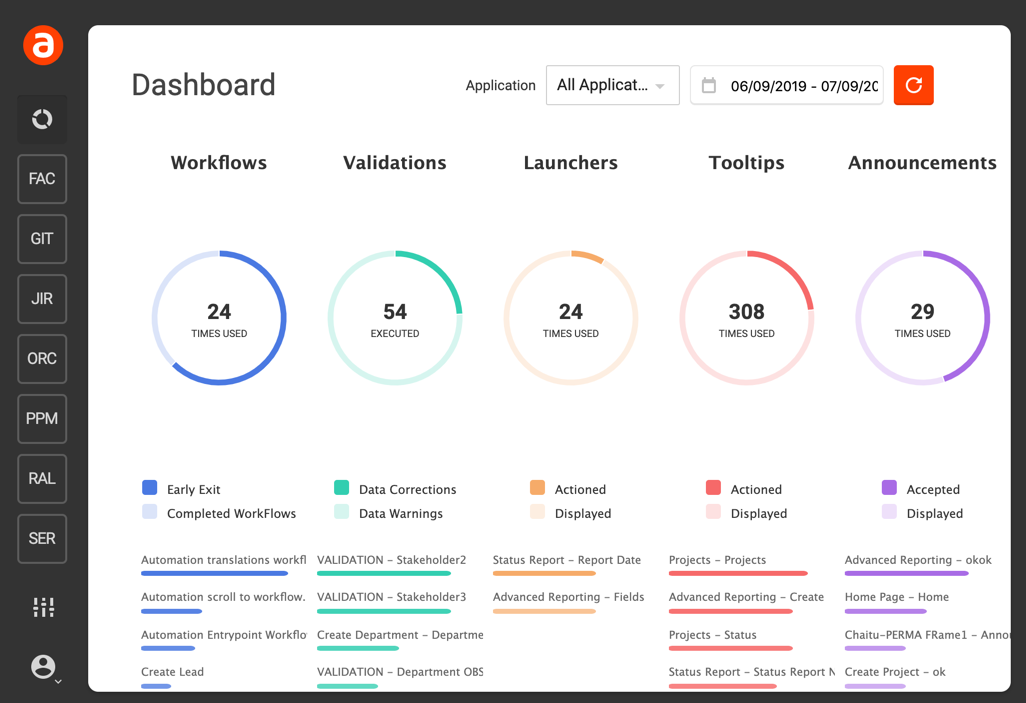
Apty dashboard.
Here’s how Apty can help with employee product adoption:
- Apty allows you to create interactive walkthroughs, onboarding flows, and product tours to help new employees discover new features and adopt your platform.
- It lets you segment your users by feature usage and then target the experiences only to the ones that haven’t adopted a certain area of your product yet.
- Apty allows you to use tooltips to engage users directly in-app.
Pros of Apty
Apty is a robust tool for your employee onboarding and adoption needs. Here are the main pros to consider if you’re still deciding:
- Apty is excellent for employee adoption, training, and onboarding. The tool makes it easy to develop in-app guidance for your new starters.
- You can either build different user segments inside the product, or you can integrate your Apty account with other tools and import your data.
Cons of Apty
While Apty is a great tool, the main downsides are the cost and restrictions you get with it. Here are the main cons of the tool:
- Apty offers tooltips and checklists for building product experience flows, but unlike other similar tools, it lacks some important UI patterns such as modals, hotspots, banners, and slideouts.
- One of the biggest disadvantages of Apty is the absence of in-app customer feedback collection. You are kind of limited to embedding surveys built using other tools.
- Doesn’t offer self-service support like a help center where users can access multiple guides and tutorials or contact support. It does provide guides that are similar but more restricted.
What users say about Apty
Overall, users feel positive about Apty– here’s an example summarizing some key points about its features and the value it offers:
Our Apty Representative, Joe Fimiani, is one of the main reasons we love working with Apty. Joe works hard to establish a trusting relationship with his customers. Joe goes above and beyond to ensure we are satisfied and happy with our Apty product by doing regular check-ins.One thing that is a little frustrating is getting past the Apty pop-up widgets. Sometimes the pop-up widgets are in the way of tabs that need to be selected. As a result, the tabs are harder to select. However, this may not be an Apty issue, rather a Clarity issue 🙂 –
Desiree G.
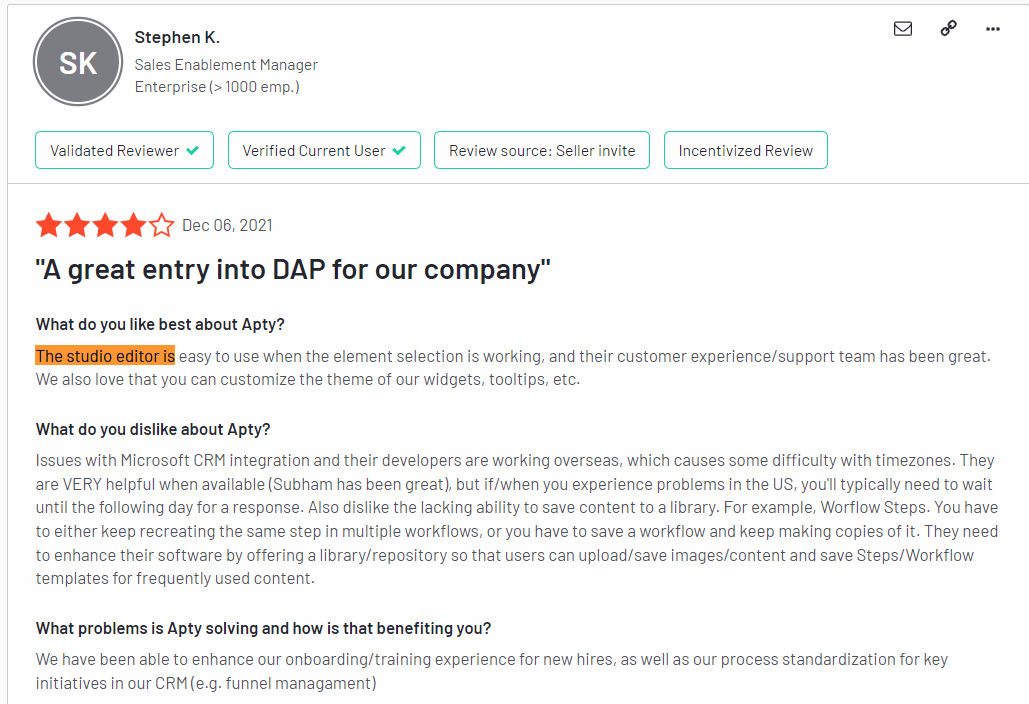
Apty review.
Most complaints are about the missing features, integrations, and the steep learning curve.
With each new release of the software, there is a bit of uncertainty in the stability of new features. Requires more attention than preferable with each new switch. Also, our tools are more complex than your standard website and that requires more work and work-arounds than expected when first acquiring a third-party onboarding tool.- Administrator in Computer Software.
UX experience when it comes to testing is cumbersome; a lot of back and forth.
Below are critical tools that are missing or need improvement. I would like to see these additions and enhancements as current features are limiting our options for solutions: Auto triggers (Related to Rule Engine, i.e. Specific page load, removing the reliance on triggers such as: Launchers, Menu Widget, and Announcement Button),IDP for standardized User Identifier,eLearning for content creators (Builder Certifications),Surveys,Chatbot etc- Paolo T.
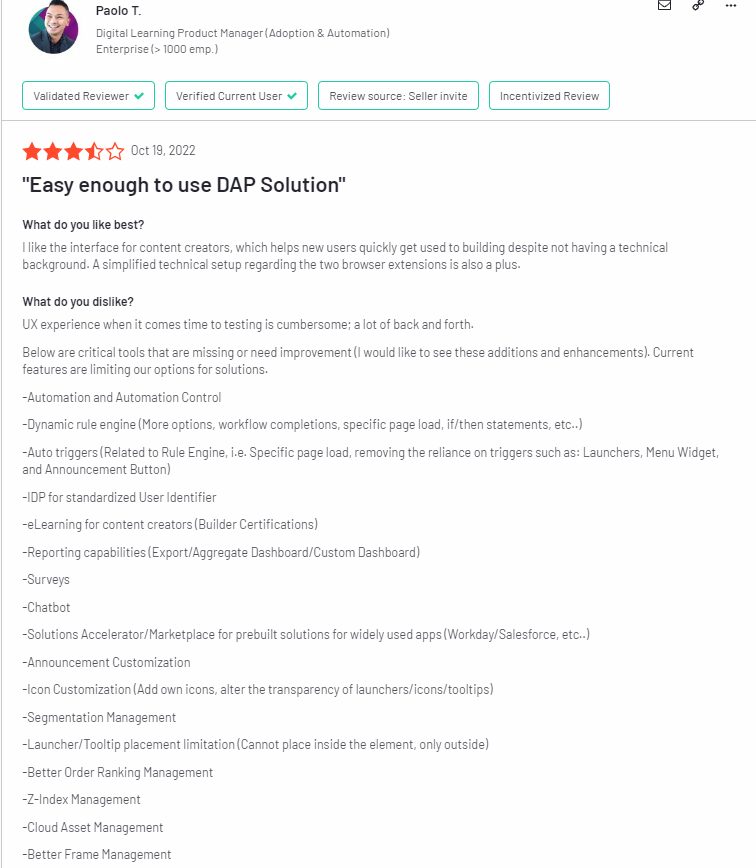
Apty review.
Is Apty the right fit for your business?
Apty is a great tool that accelerates the adoption of technologies into employees’ daily workflows. However, it has limited usability. Here are three main reasons why you might consider an alternative:
- To get access to all the needed tools for proper onboarding and adoption you need to pay for the higher plans that can get quite expensive.
- Apty doesn’t offer user feedback surveys, which are a very effective way to collect user sentiment at scale and improve employee onboarding. So if you are aiming to be more user-centric, you may need to choose another tool.
- Although Apty offers some segmentation options for more personalized training, in Userpilot you can group users on many more attributes and create more advanced segments.
Apty pricing
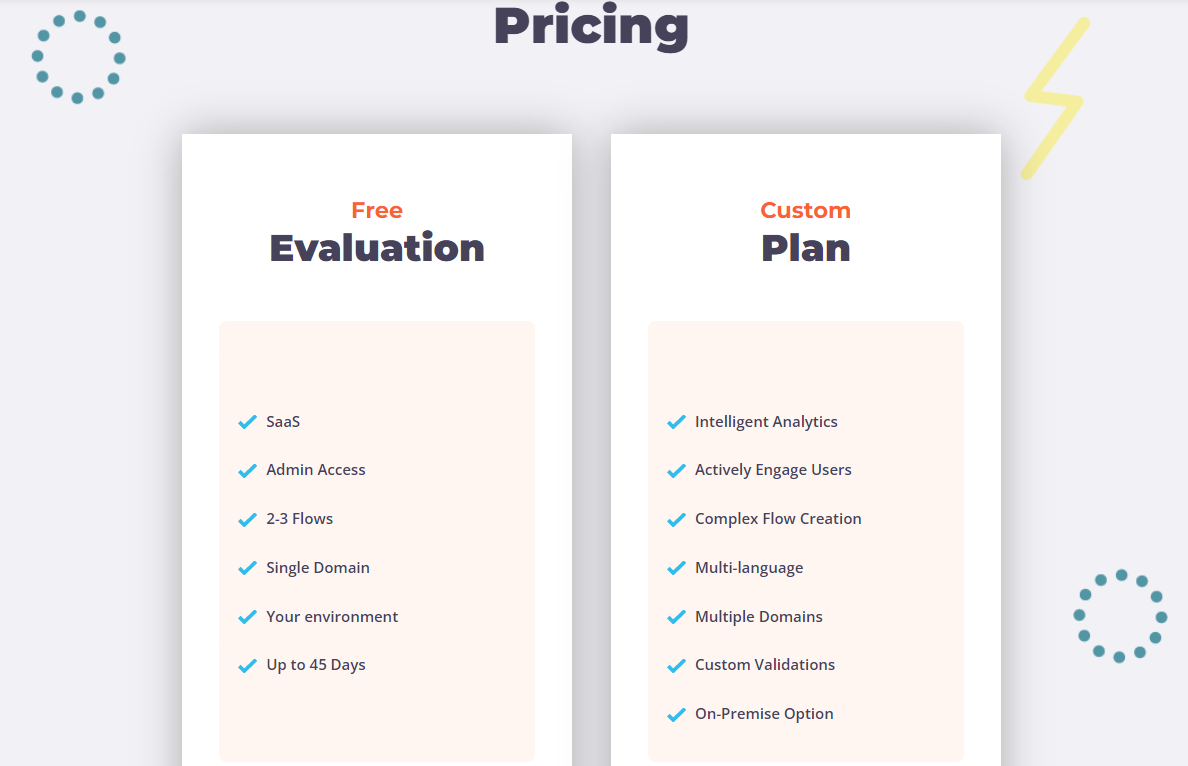
Apty pricing.
Apty offers a free trial and custom quotes based on business needs.
- Free trial: Up to 45 days, includes 2-3 flows, works on a single domain.
- Custom pricing: Intelligent analytics, complex flow creation, multilingual support, available on multiple domains.
![]()
There is a better tool for your SaaS than Apty!

Is there a better alternative for interactive user guides?
Walkme and Apty are good tools for interactive user guides. We’ve seen how they compare to each other and what you can achieve with them. Call us biased, but if you’re looking for something better, Userpilot offers more value for your money than these tools.
Userpilot for interactive user guides
Userpilot is a powerful product adoption platform that enables you to quickly build personalized, flexible, contextually relevant in-app experiences targeted to different user segments – all without writing a line of code.
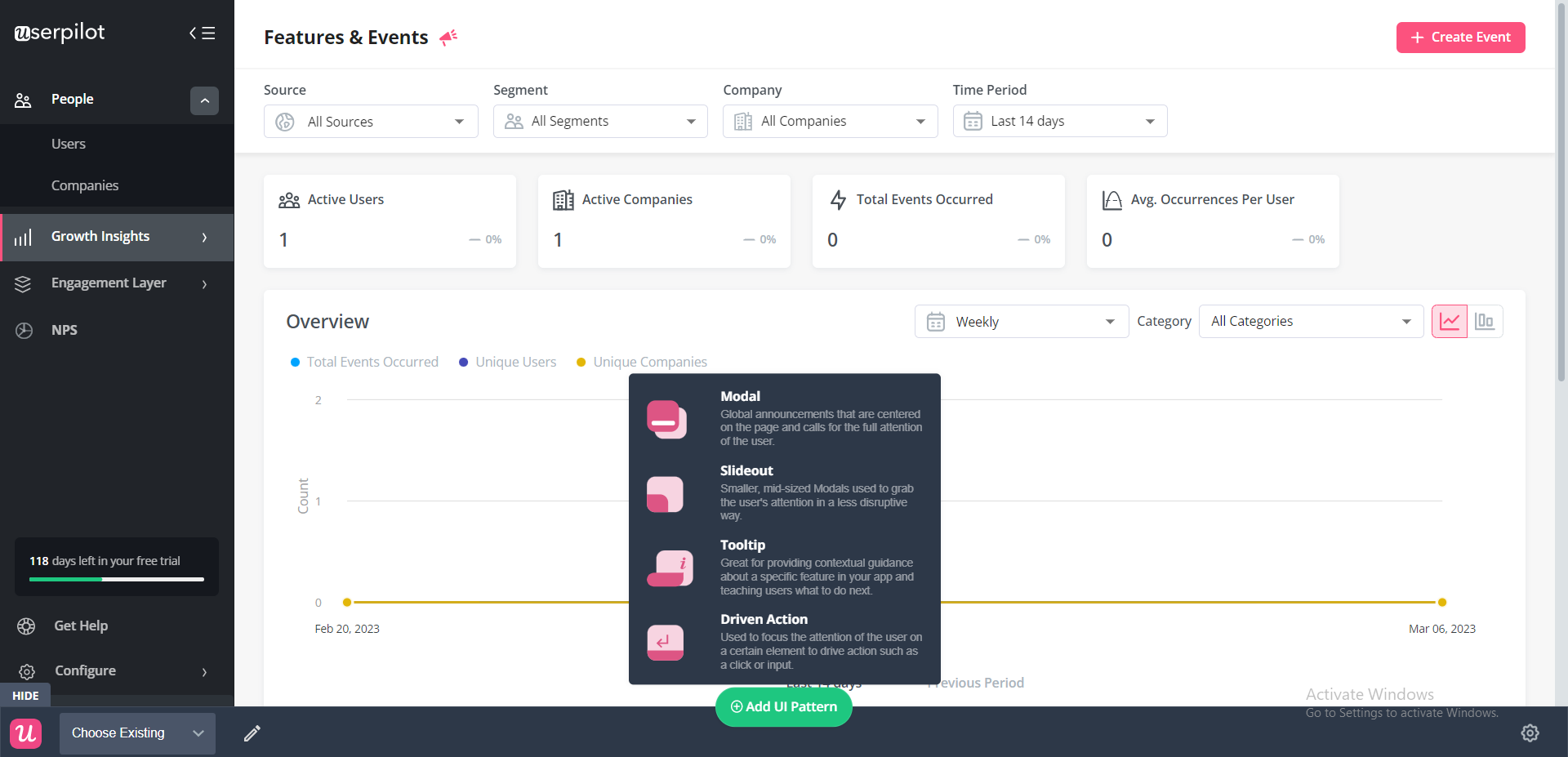
Userpilot dashboard.
Product adoption describes the process of getting users to the point where they are experiencing value from your product.
Userpilot is a powerful product adoption platform that enables you to quickly build personalized and contextual in-app experiences targeted to different user experiences – all without writing a line of code.
It’s a great option for enterprise users too since it’s SOC 2 Type II certified and offers robust features for large-scale usage.
Here are some of Userpilot’s product adoption features that you may find helpful:
- A broad range of UI patterns to build fully customizable, contextual, and interactive in-app flows: modals, slideouts, tooltips, hotspots, driven actions, banners, and more. And – most importantly – you are not limited by plan when it comes to how many UI patterns or designs you can build.
- Advanced in-app checklists with built-in gamification elements like progress bars or ”automatically marked complete” tasks: checklists also come with analytics so you can track who is interacting with them and how.
- Fully interactive walkthroughs walk users through engaging and adopting specific features of your app.
- The self-service in-app resource center lets users search your knowledge base directly inside the app, access chat, and support but also launch guides and tutorials when they get stuck.
- User feedback tools allow you to collect insights to improve the product and the user experience, thus leading to a higher product adoption rate. You can also collect NPS data and tag responses to uncover patterns into what makes users stick, or build micro surveys for more granular data. Then you can use all the feedback collected to build user segments based on the answers and personalize the path to higher product adoption for each segment.
Want to see Userpilot in action? Get a demo and improve product adoption with contextual and personalized in-app flows that actually help users.
Pros of Userpilot
Userpilot has a number of advantages, especially for mid-market SaaS companies looking for a robust but at the same time very easy-to-use, no-code tool for user onboarding, product adoption, and simplified product analytics. Let’s have a look at the pros of using Userpilot:
- No-code builder – Userpilot comes with an easy-to-use Chrome Extension builder.
- Multiple UI patterns – choose from a range of options to build customized flows: modals, slideouts, banners, tooltips, hotspots, and checklists are all at your disposal.
- UI patterns are not limited by plan – you get access to all of them on every single plan, meaning you get value even with the Traction plan (this is the entry-level one).
- Engaging walkthroughs and onboarding flows- build interactive walkthroughs targeted to distinct user segments.
- In-app help – build a resource center offering self-service support to your users, customize it with your branding, and select from a range of help options to boost user satisfaction (i.e. videos, in-app flows, chat, and more).
- Experimentation – built-in A/B testing for flows lets you explore and quickly iterate based on direct user behavior.
- Powerful feedback options- integrated NPS surveys with analytics and response tagging unlock insight into how your users feel.
- Advanced analytics and segmentation- analyze product usage and in-app flow engagement and build user segments using the data.
- Event tracking and feature tags- tag UI engagement (clicks, form fills, hovers) and group them into one custom event to track what really matters.
- More value with integrations- unlock value faster with built-in integrations with popular tools like Segment, Amplitude, Mixpanel, Kissmetrics, Intercom, Heap, and more.
Cons of Userpilot
There are, however, some downsides to Userpilot as well:
- Browser/web app only – Userpilot won’t run on mobile devices/applications.
- Doesn’t support employee onboarding- The tool is better suited for customer onboarding than for employee onboarding as you can’t build in-app guides on third-party tools.
- Missing integrations – doesn’t have built-in integrations with some tools, but it has webhooks, and Hubspot and Zapier are coming soon.
- Not appropriate for small startups on a shoestring budget (<$100)- Userpilot is a powerful, mid-market to the enterprise-level tool. So $249 a month might be too expensive for really small startups.
What users say about Userpilot

Userpilot review.
Let’s check what real users like about Userpilot.
Userpilot is an incredible, user-friendly software that allows us to create unforgettable experiences for our clients! From basic to complex experiences, we have been able to do them all with ease! I would highly recommend this software to anyone who wants to provide their clients or users with the best product tour experience. The possibilities of what you can create are endless! – Tayla G.
Userpilot is simple to set up, use, and does not require any dev – which means instant publishing. This is critical for us as a SaaS company that releases new features frequently; we need the ability to inform our customers of changes quickly, and doing this in our platform through Userpilot allows us to reach the right audience, at the right time, in the right place. There have been many awesome extra features we’ve discovered since coming on board, and it’s been great to see new features released frequently. The tool itself is intuitive and reliable. Having used similar products previously that were clunky and buggy this has really made us happy with our decision to move to Userpilot. – Melina K.
![]()
Get more value for your money with Userpilot!

Userpilot pricing
Userpilot’s transparent pricing ranges from $249/month on the entry-level end to an Enterprise tier for larger companies.
Furthermore, Userpilot’s entry-level plan includes access to all UI patterns and should include everything that most mid-market SaaS businesses need to get started.

Userpilot has three paid plans to choose from:
- Starter: The entry-level Starter plan starts at $249/month and includes features like segmentation, product analytics, reporting, user engagement, NPS feedback, and customization.
- Growth: The Growth plan starts at $749/month and includes features like resource centers, advanced event-based triggers, unlimited feature tagging, AI-powered content localization, EU hosting options, and a dedicated customer success manager.
- Enterprise: The Enterprise plan uses custom pricing and includes all the features from Starter + Growth plus custom roles/permissions, access to premium integrations, priority support, custom contract, SLA, SAML SSO, activity logs, security audit, and compliance (SOC 2/GDPR).
Conclusion
There you have it.
It should be easier now to make an informed decision between Walkme and Apty. Both tools come with advantages and disadvantages so there isn’t one that is the best. It will depend on your product and current needs.
If you want the best value for money, going with the alternative option would be our recommendation. Want to see how Userpilot can help with interactive user guides? Book a demo below.
![]()
Create interactive user guides with Userpilot!


